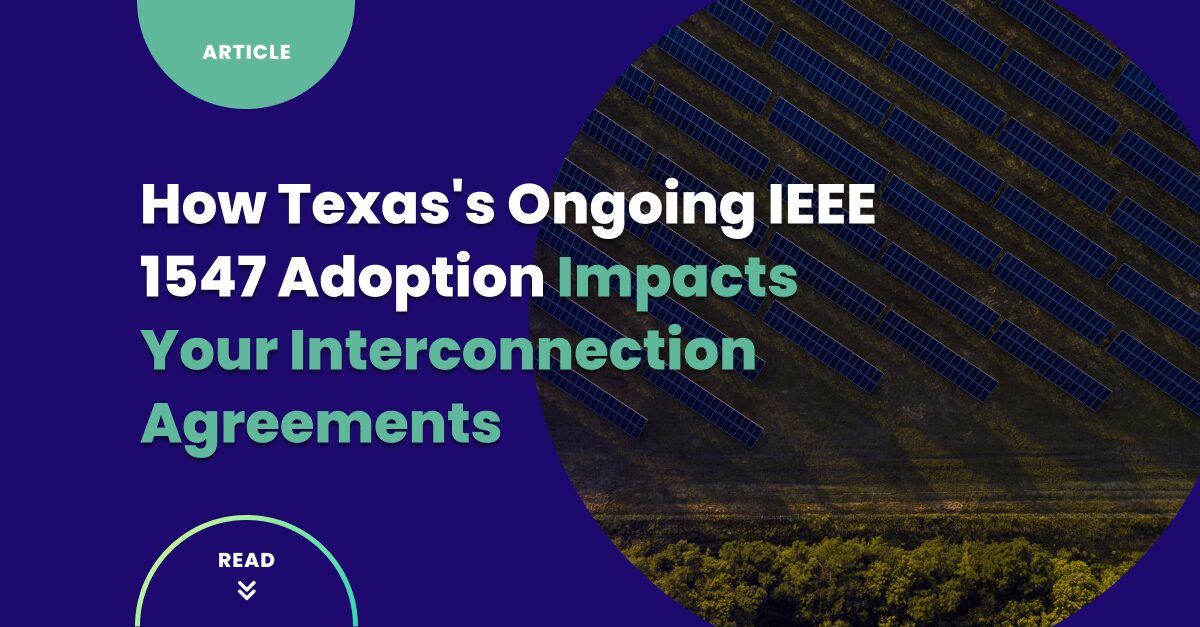How Texas’s Ongoing IEEE 1547 Adoption Impacts Your Interconnection Agreements

Are your distributed energy resource products compliant with Texas’s new interconnection rules, or are they at risk of getting stuck in the queue? The state is undergoing a significant shift to streamline and standardize DER interconnection. This is a direct response to a major bottleneck in deployment caused by a lack of standardization across different utilities. A standardized process is needed to handle the growing backlog of applications, particularly for smaller DERs. The goal is to evolve policies to match the increasing integration of DERs, and that evolution is happening now.
The Interconnection Hurdle: What You Need to Know Now
The current system has created challenges for many companies, including long delays in processing interconnection agreements and a lack of a unified process. One of the main reasons for this is the absence of a standardized communication protocol.
The Texas Public Utility Commission (PUCT) is working to change this. As part of its efforts, the IEEE 1547-2018 standard is the new baseline for new DERs. Utilities like AEP Texas have already adopted it, and the PUCT is actively working to make it a uniform requirement across the state. This means your equipment must be certified to this standard to ensure it can be approved for interconnection.
A key component of this standard is the communication mandate, also known as Annex B or Clause 10. It requires your products to support at least one of three protocols: DNP3, IEEE 2030.5, or SunSpec Modbus. Without this capability, your product could be inoperable or delayed in the interconnection process.
The Strategic Solution: A Proactive Approach to Compliance
Waiting for the final rules to be enacted is a costly mistake. For example, in April 2025, over 300 battery projects were “stuck in the utility’s interconnection queue”. The backlog is a major problem that regulators are trying to solve by creating a simplified, standardized process for smaller DERs (under 50 kW).
A proactive approach involves future-proofing your products with a flexible protocol like IEEE 2030.5. This is a strategic choice because it offers the flexibility for direct device control and is referenced in major state initiatives like the ERCOT ADER Pilot Project. The ADER program allows for the aggregation of multiple small devices—like batteries and solar systems—to participate in the wholesale market, and it requires real-time telemetry from each device at 2-second intervals. Your products need a robust communication protocol to meet this kind of requirement.
While the Texas Energy Fund (TEF) and the Texas Backup Power Package Program don’t explicitly mention communication protocols in their initial documents, companies with the latest technology will be better positioned to partner with PUCT-approved vendors for these critical facilities.
The Codibly Advantage: Streamlining Your Texas Interconnection Process
Navigating the Texas regulatory landscape doesn’t have to be a costly or lengthy process. Codibly’s IEEE 2030.5 Accelerator is a pre-built, microservice-based solution that is pre-tested with Quality Logic tools to ensure faster certification cycles and simpler regulatory sign-off. By leveraging this pre-certified solution, you can avoid months of development and testing, significantly reducing your time-to-market and gaining a competitive edge.
Our goal is to help clients not just meet the minimum requirements but to build a strategic foundation that enables them to capitalize on every new market opportunity in Texas. We offer a comprehensive approach that includes planning, implementation, and long-term ownership of the source code, freeing your team to focus on core business logic and innovation.
Securing Your Place in the Texas Market
The Texas grid is evolving rapidly, and its regulatory landscape is following suit. Waiting for the final interconnection rules to be implemented will result in costly delays. A proactive approach with a future-proof protocol like IEEE 2030.5 is the winning strategy. Don’t let your products get stuck in the interconnection queue.

contact us
Ready to accelerate your Texas market entry?
Contact us to learn how Codibly can help you secure your market position in Texas with a streamlined path to IEEE 1547 compliance.
